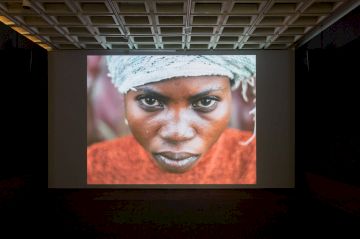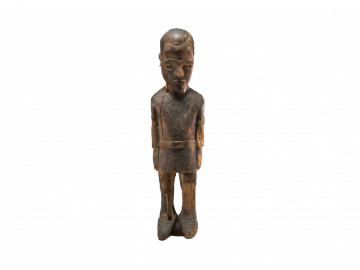CATPC – in full: Cercle d’Art des Travailleurs de Plantation Congolaise – is an art league of Congolese plantation workers who use art to attract capital, legitimization and visibility to the plantation. The cooperative operates from Lusanga, formerly known as Leverville, Unilever’s first plantation in DR Congo. Here, CATPC opened an OMA-designed arts center, where its members conceive their sculptures from river clay. Their first solo exhibition in the US was hailed as best art of the year by the New York Times. The members use the income from their art to buy back and restore their land, using the principles of agroforestry. CATPC’s goal is to develop a new innovative model of regenerative agriculture, inspired and partly financed by art: the post plantation. Providing local food security and restoring the land, their inclusive worker-owned model will provide a viable offer to the prevailing destructive monoculture plantations. Whereas on monoculture plantations, everything not directly contributing to profit maximization is banned, in the post-plantation, art lies at the fundament.
On CATPC

CATPC was founded in 2014 by a group of plantation workers who joined forces with environmental activist René Ngongo, founder of Greenpeace Congo and laureate of the Right Livelihood Award for his courage in confronting the forces that are destroying the Congo’s rainforests and building political support for their conservation and sustainable use.
The collective currently comprises nineteen members. The membership is not static: besides the group of founding members, there is a group of long-term members, as well as trainees. Below is a list of current members and trainees. The list includes members who passed away. Their work remains part of the group’s portfolio.



The main focus of the cooperative lies on sculpture. Their original, often allegorical portraits and self-portraits are reproduced in chocolate.
A description in Even Magazine (May 2017) of one of CATPC’s sculptures is illustrative for their work:
“…In Thomas Leba’s Poisonous Miracle (2015), an old woman gazes down in horror at her foot, which has been trapped in the maw of a mammoth chameleon. From one angle, the couple form a single unit, anchored architecturally by her down-stretched arm. But the sculpture seems to press forward into space as one circles it: the figure detaches from the beast, and its poignant profile — mouth gaping and palm upturned as though baffled by the chameleon’s ferocity — is complemented by ornamental leaves embossed into the spandrel between the reptile and her leg. The transformations of the chameleon infect the sculpture itself, as it folds out of the monolithic block of brute material. Yet the chameleon is also an allegorical figure for another transformation: the arrival of capitalism to the Congo. The choice of Belgian chocolate as a medium reflects this history, one in which cocoa beans were sent to Europe, but nothing rich — and certainly no chocolate — was sent back. Plantations were not just operations; they were ideologies, justifying the treatment of resources, people, and their sculptural “fetishes” alike as raw material that must subsequently be refined into first-world luxuries. A plantation workers’ art collective is transgressive because it establishes intimacy with material has been historically denied to them: not chocolate, but sculpture.” (Joanna Fiduccia, Even Magazine, 2017)
Besides sculpture, the collective uses drawing, video, photography and film.


With the income from their art, CATPC buys back the land that was taken from them by plantation companies, such as Unilever. Until now they have bought back 85 hectares of land where they developed ecological test gardens. The aim is to buy back 2.000 hectares of land, which, in many cases is totally depleted by the plantation. Using agroforestry techniques, the collective restores the land, thereby mitigating climate change, and importantly, providing local food security.
On the 85 hectares, the collective built an arts center, comprising an atelier, a conference room, and at its heart, a museum, designed by OMA. CATPC runs this museum together with its partner the Institute for Human Activities. CATPC curated the inaugural exhibition of this White Cube, which unveiled CATPC’s latest works of that moment (April 2017), alongside contributions by other prominent Congolese and international artists, including Sammy Baloji, Kader Attia, Marlene Dumas, and Luc Tuymans. In 2021, the museum will show an exhibition of the work by Ibrahim Mahama.


CATPC works together with numerous international partners. Besides its representation by KOW, CATPC collaborates with The Institute for Human Activities (Amsterdam), a long-term collaborator of CATPC. The institute’s goal is to prove that artistic critique on economic inequality can redress it – not symbolically, but in material terms. Another partner is OMA – Rem Koolhaas’ Office of Metropolitan Architecture – that designed the masterplan for CATPC’s art center and the quintessential white cube that is at the heart of it. OMA also brings in its expertise for the design of the exhibitions of new CATPC sculptures.
CATPC

















CATPC – Cercle d’art des travailleurs de plantation congolaise – is an art cooperative of plantation workers based in Lusanga, D.R.Congo. CATPC was founded in 2014 with renowned environmental activist René Ngongo. Over the past decade, they have reconnected to a history of artistic resistance against the plantation system and developed a practice of getting hundreds of acres of exhausted plantation land with the proceeds of their art. On this land they bring back the forests that were cut down by the plantation companies and develop their ecological and inclusive food garden the “Post-Plantation” with the proceeds of their art.
At the heart of that reclaimed land, they built a museum, the White Cube Lusanga. In 2024, they represented the Netherlands at the Venice Biennale, presenting a dual exhibition in Venice and Lusanga. They also secured the temporary return of the ancestral sculpture Balot to Lusanga for the duration of the Biennale – a powerful act of reconnection between the community and its history of resistance against the plantation system.
Recent solo exhibitions include SculptureCenter (New York, 2017), the Dutch pavilion at the 60th Venice Biennale (2024), and the Van Abbemuseum (Einhoven, 2024). Other exhibitions include Sydney Biennale (2017), Dig Where You Stand (Ghana, 2022), Diriyah Contemporary Art Biennale (2024).
- Anna Boghiguian
- Candice Breitz
- Marco A. Castillo
- CATPC
- Alice Creischer
- Chto Delat
- Clegg & Guttmann
- Eugenio Dittborn
- Heinrich Dunst
- Anna Ehrenstein
- Peter Friedl
- Sophie Gogl
- Barbara Hammer
- Ramon Haze
- Hiwa K
- Hudinilson Jr.
- Simon Lehner
- Renzo Martens
- Oswald Oberhuber
- Mario Pfeifer
- Dierk Schmidt
- Santiago Sierra
- Michael E. Smith
- Franz Erhard Walther
- Clemens von Wedemeyer
- Tobias Zielony